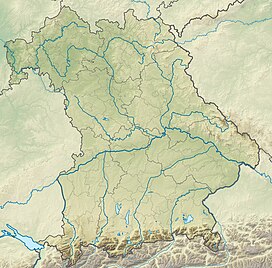
The Saale, also known as the Saxon Saale and Thuringian Saale, is a river in Germany and a left-bank tributary of the Elbe. It is not to be confused with the smaller Franconian Saale, a right-bank tributary of the Main, or the Saale in Lower Saxony, a tributary of the Leine.

The Fichtel Mountains, form a small horseshoe-shaped mountain range in northeastern Bavaria, Germany. They extend from the valley of the Red Main River to the Czech border, a few foothills spilling over into the Czech Republic. They continue in a northeasterly direction as the Elster Mountains, and in a southeasterly direction as the Upper Palatine Forest. The Fichtel Mountains contain an important nature park, the Fichtel Mountain Nature Park, with an area of 1,020 square kilometres (390 sq mi).
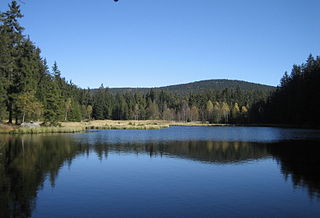
Fichtelberg is a municipality in the district of Bayreuth in Bavaria in Germany. It is a state-recognised climatic spa.

Sparneck is a municipality in Upper Franconia in the district of Hof in Bavaria in Germany.
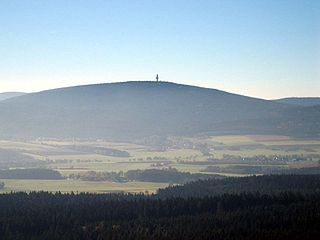
Schneeberg is the highest mountain in the Fichtel Mountains, a mountain range in Upper Franconia in northeast Bavaria, Germany. It can be readily identified from a distance by its squat tower - a relic of the Cold War. The summit comprises a jumble of granite rocks and a rock pillar (Felsburg) on which the Backöfele observation tower stands and is still dominated by the relics of military installations including its Cold War listening post.

The Fichtel Mountain Nature Park lies in the tri-border area of Saxony, the Czech Republic and Bavaria and has an area of 1,020 km2 (390 sq mi). It is maintained by the Naturpark Fichtelgebirge e. V. in Wunsiedel.
The Kohlberg is a forested mountain made of quartz phyllite in northeast Bavaria, south of Arzberg. Its summit is 632 m above sea level (NN) high and it is one of the highest mountains in the Fichtel Mountains.

The Röslau or Rösla is a right-hand tributary of the river Ohře in northeast Bavaria in Germany.

The Fichtelgebirge Club is a large walking club and local heritage society in Bavaria and recognised conservation group with 20,000 members in 55 local groups. As the name says, its main sphere of activity is in the Fichtel Mountains in north Bavaria. Its emblem is the Arctic starflower.

The Kösseine is a massif in the High Fichtel mountains in Germany, lying in northeast Bavaria south of Wunsiedel. The highest elevation of this granite massif is the summit of the Große Kösseine, 939 m above sea level (NN). The border between the Bavarian provinces of Upper Franconia and Upper Palatinate runs over the Kösseine as does the European watershed between the North Sea and the Black Sea. Around the Kösseine are the settlements of Wunsiedel, Marktredwitz, Bad Alexandersbad, Waldershof, Hohenhard, Neusorg, Brand, Ebnath, Nagel and Tröstau, tourist resorts within the Fichtel Mountains.
The Nußhardt is the third highest mountain in the Fichtel Mountains in the south German state of Bavaria at 972 m above sea level (NN). It lies in the far northeast of the state and has a rocky summit characteristic of the Fichtel Mountains. The summit area with its felsenmeer and tor is a nature reserve with an area of 5.5 hectares. In addition the Nußhardt is incorporated into the geotope register of the Bavarian State Geological Department under No. 472R013.

The Steinwald is a mountain range up to 946 m above sea level (NN) in southern Germany and, at the same time, a nature park founded in 1970 with an area of 246 square kilometres (95 sq mi) in the province of Upper Palatinate, in North Bavaria.
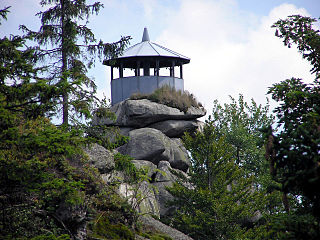
The Großer Waldstein is part of the Waldstein range in the Fichtel Mountains of Germany. It is known primarily for its rock formations caused by spheroidal weathering, its ruined castles and the only remaining bear trap (Bärenfang) in the region.

The Waldstein is a mountain range in the northern part of the Fichtel Mountains in Upper Franconia, Bavaria, in southern Germany.

The Waldsteinburg, also called the Red Castle is a ruined castle on the summit of the Großer Waldstein in the Fichtel Mountains of Germany. It is also known as the Westburg to distinguish it from the older ruins of the Ostburg.

With its 827-metre-high (2,713 ft) peak the Große Kornberg is the northeast cornerstone of the Fichtel Mountains in south Germany. It forms a wooded ridge, which is recognisable from a long distance by its former military surveillance tower It is also the local 'house' mountain of Schönwald and Schwarzenbach an der Saale.
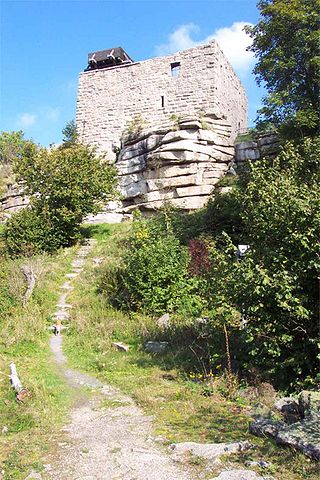
The Epprechtstein is a mountain in the northern Fichtel Mountains in northeast Bavaria, Germany, 798 m above sea level (NN). It is mineralogically the most interesting mountain in the entire Fichtel range. Around the summit there are about 20 quarries, in three of which Epprechtstein granite is quarried. The others are closed and partially overgrown.
The Königsheide is a high, forested ridge, made of gneiss-phyllite rock in the Fichtel Mountains in Bavaria, Germany. It is located to the southwest of the Ochsenkopf mountain. It is bordered to the east and south by the river of the Warme Steinach, and to the west by the Franconian Line. The villages of Warmensteinach and Weidenberg and the town of Goldkronach lie on the Königsheide.

The Hoher Stein is a rock formation at the northeastern foot of the Bergkopf mountain, part of the Waldstein ridge in Germany's Fichtel Mountains.

The High Fichtel Mountains, or High Fichtel, form a mountainous and heavily forested range consisting of several mountain chains in the shape of a horseshoe, the Fichtel Mountain Horseshoe (Fichtelgebirgs-Hufeisen), that rings the Selb-Wunsiedel Plateau.

